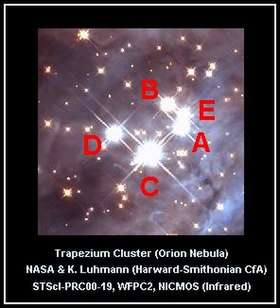| Observation data Epoch J2000 Equinox J2000 | |
|---|---|
| Constellation | Orion |
| Right ascension | 05h 35m 15.773s[1] |
| Declination | −05° 23′ 10.02″[1] |
| Apparent magnitude (V) | 11.40 - 11.81[2] |
| Characteristics | |
| Evolutionary stage | PMS[3] |
| Spectral type | G2 IV[4] |
| Variable type | Eclipsing[3] |
| Astrometry | |
| Radial velocity (Rv) | 34.3[5] km/s |
| Proper motion (μ) | RA: 1.45±0.03[6] mas/yr Dec.: 1.02±0.08[6] mas/yr |
| Parallax (π) | 2.557 ± 0.051 mas[6] |
| Distance | 1,280 ± 30 ly (391 ± 8 pc) |
| Absolute magnitude (MV) | +1.43[7] |
| Orbit | |
| Period (P) | 9.89520 ± 0.0007[4] days |
| Semi-major axis (a) | 34.430 ± 0.193[3] R☉ |
| Eccentricity (e) | < 0.001[4] |
| Inclination (i) | 73.7 ± 0.9[3]° |
| Semi-amplitude (K1) (primary) | 84.2 ± 1.2[4] km/s |
| Semi-amplitude (K2) (secondary) | 84.6 ± 1.3[4] km/s |
| Details | |
| A | |
| Mass | 2.807 ± 0.048[3] M☉ |
| Radius | 7.1[7] R☉ |
| Luminosity | 29[8] L☉ |
| Temperature | 6,000[3] K |
| Rotational velocity (v sin i) | 37[8] km/s |
| B | |
| Mass | 2.797 ± 0.048[3] M☉ |
| Radius | 7.1[7] R☉ |
| Luminosity | 29[8] L☉ |
| Temperature | 6,000[3] K |
| Rotational velocity (v sin i) | 37[8] km/s |
| Age | 500[8] Myr |
| Other designations | |
| Database references | |
| SIMBAD | data |
θ1 Orionis E (Latinised as Theta1 Orionis E) is a double-lined spectroscopic binary located 4' north of θ1 Orionis A in the Trapezium Cluster. The two components are almost identical pre-main-sequence stars in a close circular orbit, and they show shallow eclipses that produce brightness variations of a few tenths of a magnitude.

Each component of the binary system is slightly under 3 M☉. Although they have a subgiant spectral classification, they are still contracting onto the main sequence and are estimated to be only about 500 million years old.[8] It is estimated that they will reach the main sequence as smaller hotter late-B stars.[7]
The variability was first reported in 1954[2] and confirmed as an eclipsing binary in 2012. It has not been assigned a variable star designation but is listed in the New Catalogue of Suspected Variable Stars.[2]
- ^ a b Cite error: The named reference
2masswas invoked but never defined (see the help page). - ^ a b c Cite error: The named reference
nsvwas invoked but never defined (see the help page). - ^ a b c d e f g h i Cite error: The named reference
m-cwas invoked but never defined (see the help page). - ^ a b c d e Cite error: The named reference
costerowas invoked but never defined (see the help page). - ^ Cite error: The named reference
olivareswas invoked but never defined (see the help page). - ^ a b c Cite error: The named reference
Kounkel2017was invoked but never defined (see the help page). - ^ a b c d Cite error: The named reference
herbigwas invoked but never defined (see the help page). - ^ a b c d e f Cite error: The named reference
huenemoerderwas invoked but never defined (see the help page).
